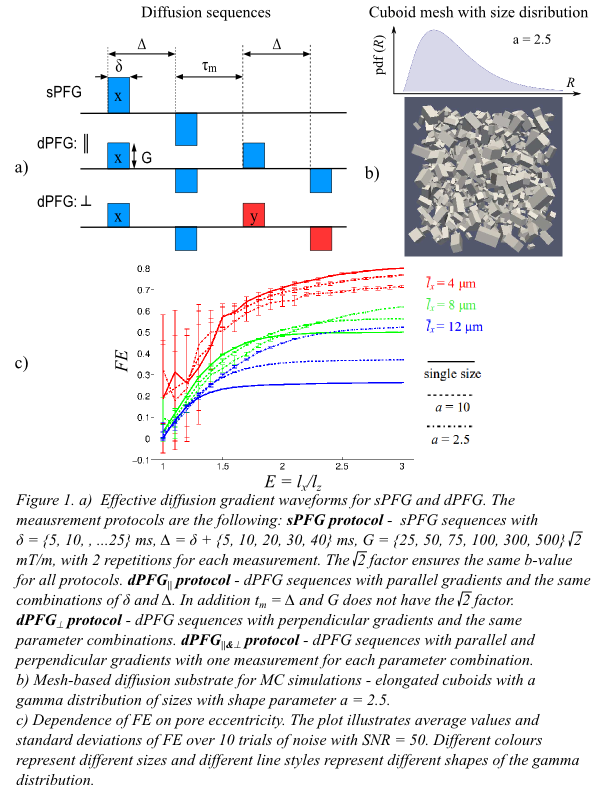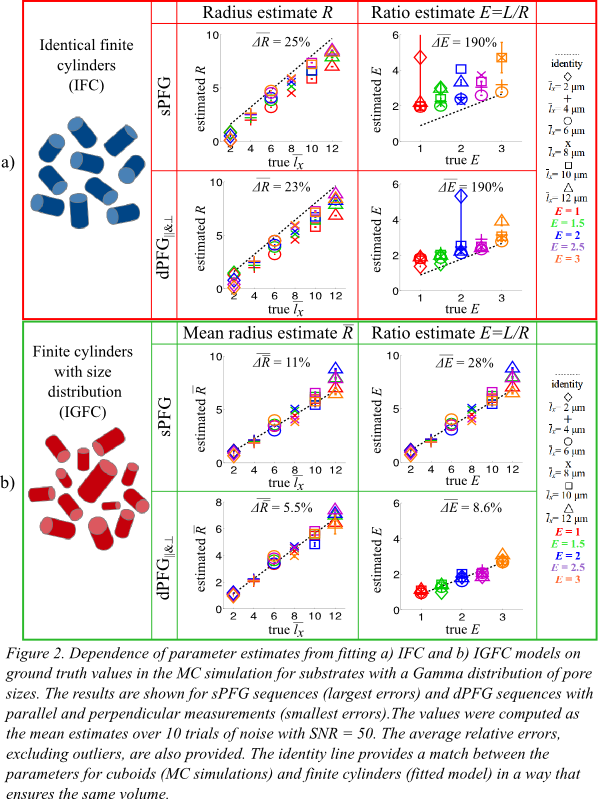Postersession - P-028
Model-based estimation of microstructure parameters from diffusion MRI in the presence of microscopic anisotropy and size dispersion
- UCL, London, United Kingdom
Introduction Standard metrics of microscopic anisotropy such as fractional eccentricity (FE) [1] lack specificity, because they intrinsically depend on sequence parameters and are not invariant to size distribution, as illustrated in Figure 1c. This issue can be solved by explicitly modelling microstructure, nevertheless, previous work investigated only substrates of identical pores [2]. Here we explore a model-based approach to estimate pore size and elongation in substrates featuring a distribution of pores.

Methods
Methods Data synthesis: Monte Carlo (MC) diffusion simulations with mesh based substrates of randomly oriented cuboids with various elongations and a gamma distribution of sizes: mean length lx = {4, 6, 8, 10, 12} μ m, elongation lz/lx = {1, 1.5, 2, 2.5, 3} , shape of gamma distribution a = 2.5 and diffusivity D = 2E-9 s/m2. An example is shown in Figure 1b. Diffusion sequences: We investigate protocols with single pulsed field gradient (sPFG) sequences as well as double PFG sequences with parallel, perpendicular or combined gradients. The sequences and measurement parameters are given in Figure 1a. Model fitting: We derive analytical signal expressions for the four protocols and tissue models with isotropically oriented finite cylinders (ICF) and finite cylinders with a gamma distribution of radii (IGFC).

Results
Results Figure 2 shows the dependence of estimated microstructure parameters on ground truth values from fitting the IFC and IGFC models. The results are shown for the protocols with largest and smallest errors, sPFG and dPFG||& | , respectively. Fitting a model of identical pores to a substrate with a size distribution of pores results in biased estimates, with underestimated size and overestimated elongation. Explicitly accounting for size distribution improves the estimates, significantly reducing the average relative errors of radius and eccentricity. The shape parameter of the gamma distribution a was fitted as well, with estimates close to ground truth values.
Discussion This work shows the feasibility of using a model-based approach to estimate pore size and eccentricity in substrates with a distribution of sizes. We also show that the dPFG||& | protocol yields the best estimates, nevertheless, sPFG measurements show sensitivity as well.
- [1] S. N. Jespersen, H. Lundell, C. K. Sonderby, and T. B. Dyrby, (2013), Orientationally invariant metrics of apparent compartment eccentricity from double pulsed field gradient diffusion experiments. , NMR in Biomedicine, 26:1647-1662
- [2] E. Ozarslan, (2009), Compartment shape anisotropy (CSA) revealed by double pulsed field gradient MR, Journal of Magnetic Resonance, 199:56-67.
